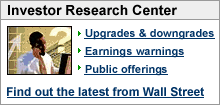Dow, S&P 500 touch recordsMajor gauges near all-time highs on bets that the jobs report means the economy is holding up; bond prices slump on bets that Fed won't cut at next meeting.NEW YORK (CNNMoney.com) -- Stocks rallied Friday after a strong September jobs report raised bets that the economy will be able to avoid a recession, despite the drag from the housing and mortgage market meltdown. Bond prices slumped, boosting the corresponding yields on bets that if the economy is holding up better than thought, the Fed won't necessarily need to keep cutting interest rates. The Dow Jones industrial average (Charts) gained 0.9 percent with 20 minutes left in the session after having hit a record trading high of 14,123.72 earlier in the afternoon. Should the blue-chip average end where it stood around 3:40 p.m. ET, it would be at a new all-time high. The broader S&P 500 (Charts) index added about 1 percent, briefly hitting a new all-time intraday high of 1561.91 before scaling back a little. The tech-heavy Nasdaq composite (Charts) gained around 1.7 percent. Should it close where it stood at 2:15 p.m. ET, it would be at a fresh 2007 record and the highest close since Feb. 2001. Employers added 110,000 jobs to their payrolls in August, just topping forecasts for a rise of 100,000. In addition, the August number was revised to a gain of 89,000 jobs from the originally reported loss of 4,000 jobs. Despite the gain in payrolls, the unemployment rate, which is generated by a separate survey, rose to 4.7 percent in the month from 4.6 percent in the previous month. The gain was as expected. The report seemed to hit that middle ground that stock investors crave, suggesting the economy is holding up, but not accelerating too quickly. "Stand alone, this was a good employment report," said Gregory Miller, chief economist at SunTrust Banks. "In context, it probably doesn't change the underlying theme that this economy and this labor market have been stair-stepping downwards." Overall it suggested that the economy hasn't fallen apart, but is also not reaccelerating too rapidly, Miller said. Recent weak reports on manufacturing and durable goods orders had raised bets that problems in the housing sector were spreading to the broader economy. While that still may prove to be true, the jobs report at least tempered worries about the extent of any pullback in the labor market. In terms of what it might mean for interest-rate policy, the report would seem to diminish the likelihood of the Federal Reserve cutting interest rates at its meeting at the end of the month, Miller said. The report's inflation component seemed to support the Fed holding off. Average hourly earnings rose 0.4 percent after rising 0.3 percent in August. Economists thought wages would rise 0.3 percent. Treasury prices slumped, boosting the corresponding yields, on bets that the Fed won't cut rates at the end of the month. The selloff lifted the yield on the 10-year note to 4.64 percent from 4.51 percent late Thursday. However, the possibility that the Fed won't cut again at the end of the month didn't seem to rattle stock investors as it might have a few weeks ago. "For the stock market, sometimes it reads Fed easing as good news, sometimes not," Miller said. "I think for today, stock investors are reading the potential for no more Fed easing as positive because it means that conditions are not so bad that the Fed will need to ease." Fed Vice Chairman Donald Kohn, speaking to the Philadelphia Chamber of Commerce, said that while financial market conditions have improved since the Fed cut interest rates on Sept. 18, liquidity in the credit markets is not back to normal. He also said that the Fed's policy action won't stem the problems in the economy for several quarters, with the housing market in particular likely to continue to lag for some time In corporate news, Merrill Lynch joined the recent parade of financial companies warning about the earnings impact from the fallout in the housing and credit markets. Merrill said it will post a third-quarter net loss of about 50 cents per share and will write down about $5.5 billion. Nonetheless, Merrill (Charts, Fortune 500) shares rose, with investors continuing to reward financial companies for not disappointing them even more with their earnings reports, relative to grim expectations. In addition, a sense that the worst is over for the sector has helped the stocks recently after a tough third quarter. Bears Stearns (Charts, Fortune 500) is reportedly the focus of a criminal probe related to the collapse of two of its mortgage-related hedge funds. Bear stock slipped about 1 percent on the news. Late Thursday, Research in Motion (Charts) reported higher quarterly earnings and revenue that beat expectations. The Blackberry maker also boosted its current-quarter profit forecast. Shares jumped 13 percent Friday. Also after the close Thursday, Alcoa (Charts, Fortune 500) said it will sell two of its divisions and that it will restructure another one. Shares of the Dow component rose 3.6 percent Friday. Other Dow gainers included Caterpillar (Charts, Fortune 500), Merck (Charts, Fortune 500), Home Depot (Charts, Fortune 500), American Express (Charts, Fortune 500) and Citigroup (Charts, Fortune 500). Among other movers, Yahoo (Charts, Fortune 500) shares gained after an analyst report said that breaking up the company could boost its share value. Market breadth was positive. On the New York Stock Exchange, winners beat losers by more than 3 to 1 on volume of 1 billion shares. On the Nasdaq, advancers topped decliners by almost 3 to 1 on volume of 1.77 billion shares. In currency trading, the dollar slipped versus the euro and gained versus the yen. U.S. light crude for November delivery fell 22 cents to $81.22 a barrel on the New York Mercantile Exchange. COMEX gold for December delivery rose $3.40 to $747.20 an ounce. |
|




